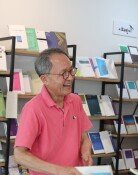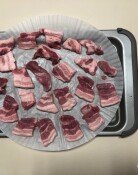SNU Specimen Mismanagement Revealed
SNU Specimen Mismanagement Revealed
Posted December. 01, 2005 03:22,
When a reporter unlocked a padlock atop the bioengineering building of the natural sciences department of Seoul National University (SNU) yesterday afternoon after climbing stairs littered with bottles of formalin, there was a container on the 40-odd pyeong roof. One corner of the container had a stack of waste-like objects, dozens of specimen boxes wrapped in plastic bags.
Inside the boxes were rare animal specimens, so withered that one couldnt recognize them. The markings and thick layer of dust on and in the boxes indicated that the specimens have not properly been managed since 1997.
Since the container is a makeshift building, the district office keeps demanding it should be destroyed. says SNU Professor Song Seong-jun. Without the basic elements of a ventilation system and an air conditioner for a specimen room, the container is being powered illegally.
The bio-engineering department of Seoul National University that boasts of the largest number of rare animal specimens in this country is on the brink of terminating them due to a lack of space. The department has failed to acquire the space to keep the existing ones prior to its relocation to the new building of Brain Korea, in 2006.
Although support for application sciences like bioengineering is increasing sharply, basic sciences like life classifications are being ignored.
Leaving valuable specimens alone-
Currently, Seoul National Universitys colleges of natural science, and agriculture and life sciences have about 680,000 animal and plant specimens. The 20,000 plant specimens of the national science college, in particular, are invaluable in research because they are the only North Korean plant specimens in South Korea. But these specimens are being neglected.
The container on the roof, installed by professors with their own money in 1997, has classified nearly 10,000 animal specimens. The number of unclassified animal specimens amounts to some 50,000. Tens of thousands of insect specimens have decayed owing to poor management. So could thousands of stuffed specimens of fish, birds and mammals. Plant specimens are also piled up in cabinets of labs and some are being harmed by insects.
Since they have never been counted in one place, it is impossible to figure out how many specimens there are, says bio-engineering professor Kim Won. Of some 1,000 samples collected in a year, about 60 percent of them are deformed or destroyed as a result of the shortage of space and poor management.
Professor Choi Jae-cheon, who found the scarce insect cryptocercus a few years ago, sent the specimen to the Muséum National d`Histoire Naturelle in France after a period of deliberation. He said, Although I knew that I wouldnt be able to get it back, I sent it for fear of losing it because of the lack of a proper specimen room for it.
Poor awareness about basic science-
The crisis of basic sciences like life classification comes from focusing financial aid on technology development, which produce visible results.
About one third of professors studying basic sciences dont get a single penny in research aid says bio-engineering professor Park Jong-uk. Basic sciences, the foundation for developing new material, are dying.
In foreign countries, classification scholars are always involved in researching and advising on extracting medicines and developing new medicines, hitting the jackpot. The world-renowned anti-febrile drug Aspirin is made from willow substances in Germany. Foreign universities get taskforces and volunteers to manage rooms for animal and plant specimens.
The school has always failed to give even a room for keeping specimens, citing budget shortages, says agriculture and life sciences professor Jang Jin-seong, who is also head of SNUs specimen management. The animal and plant specimens are even considered to be litter occupying space.
Se-Jin Jung mint4a@donga.com







